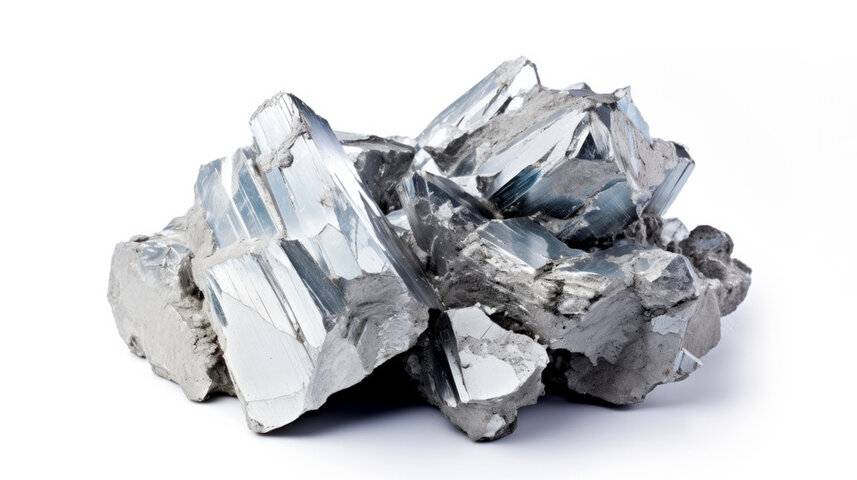Is zinc magnetic? This question often arises when discussing this versatile metal. Despite its widespread use, zinc is not magnetic. Unlike iron or nickel, zinc's atomic structure lacks unpaired electrons, making it diamagnetic. This means it weakly repels magnetic fields rather than being attracted to them.
Zinc's non-magnetic nature is valuable in various applications, particularly where magnetic interference must be avoided. From corrosion-resistant coatings to electromagnetic shielding in electronics, zinc's unique properties make it indispensable in modern industry.
Understanding zinc's non-magnetic character not only clarifies a common misconception but also highlights the importance of diverse material properties in technology and die casting manufacturing.

1. What is Zinc and What is Magnetism
Zinc, a bluish-white metal with atomic number 30, plays a crucial role in various industries. Discovered in its metallic form in 1746 by Andreas Marggraf, zinc has become indispensable in modern life. According to the U.S. Geological Survey, global zinc production reached approximately 13.2 million metric tons in 2020, highlighting its significance in the industrial world.
Understanding the magnetic properties of materials is essential for numerous applications, from everyday gadgets to cutting-edge technologies. As we delve into zinc's relationship with magnetism, we'll uncover fascinating insights about this versatile element and its unique place in the periodic table.
2. Zinc's Magnetic Nature
2.1 Zinc's Classification
Zinc falls into the category of diamagnetic materials. This classification might sound complex, but it simply means that zinc exhibits a weak repulsion when exposed to magnetic fields. The diamagnetic property of zinc is quantified by its magnetic susceptibility, which is approximately -1.56 × 10⁻⁵ (dimensionless SI units) at room temperature.
2.2 Magnetic Response
When subjected to an external magnetic field, zinc's response is quite different from what we observe in common magnetic materials like iron. Instead of being attracted, zinc weakly pushes away from the magnetic source. This behavior can be demonstrated through the Faraday method, where a small piece of zinc suspended by a thin thread will be slightly repelled when a strong magnet is brought near it.
To illustrate this behavior, consider the following table comparing magnetic susceptibilities:
| Material Type | Magnetic Susceptibility (χ) | Examples |
| Ferromagnetic | Large positive (>1000) | Iron (χ ≈ 200,000) |
| Paramagnetic | Small positive (0 to 1) | Aluminum (χ ≈ 2.2 × 10⁻⁵) |
| Diamagnetic | Small negative (-1 to 0) | Zinc (χ ≈ -1.56 × 10⁻⁵) |
3. Why Zinc is Not Magnetic
3.1 Atomic Structure of Zinc
Zinc's lack of magnetic properties can be traced back to its electron configuration. The arrangement of electrons in zinc's outer shell plays a crucial role in determining its magnetic behavior.
Zinc's electron configuration is [Ar]3d⊃1;⁰4s⊃2;. This means all of zinc's electrons are paired, leaving no unpaired electrons in its outermost orbital. The absence of unpaired electrons is key to understanding why zinc doesn't exhibit magnetic properties.
To visualize this, let's compare zinc's electron configuration with that of a magnetic element:
| Element | Electron Configuration | Unpaired Electrons |
| Zinc | [Ar]3d⊃1;⁰4s⊃2; | 0 |
| Iron | [Ar]3d⁶4s⊃2; | 4 |
3.2 Magnetic Moment in Zinc
Due to its fully paired electrons, zinc has a magnetic moment of zero. This contrasts sharply with ferromagnetic materials like iron, which have unpaired electrons that can align in a magnetic field, creating a net magnetic moment.
The magnetic moment (μ) of an atom can be calculated using the formula:
μ = √[n(n+2)] μB
Where n is the number of unpaired electrons and μB is the Bohr magneton (9.274 × 10⁻⊃2;⁴ J/T).
For zinc: n = 0, so μ = 0 For iron: n = 4, so μ ≈ 4.90 μB

4. Factors Affecting Zinc's Magnetic Properties
4.1 Purity and Impurities
While pure zinc is diamagnetic, impurities can sometimes alter its magnetic behavior. Certain impurities may create localized magnetic moments, potentially leading to weak paramagnetic behavior. However, this effect is typically so minimal that it remains unnoticeable in everyday applications.
A study published in the Journal of Magnetism and Magnetic Materials (2018) found that zinc nanoparticles doped with 5% manganese showed weak ferromagnetic behavior at room temperature, with a saturation magnetization of 0.08 emu/g.
4.2 Temperature
Temperature also plays a role in zinc's magnetic behavior. As temperature increases, any potential magnetic effects due to impurities are further diminished. This occurs because thermal energy disrupts the alignment of electrons, reducing any slight magnetic tendencies.
The relationship between temperature and magnetic susceptibility for diamagnetic materials like zinc follows Curie's law:
χ = C / T
Where C is the Curie constant and T is the absolute temperature. For zinc, the temperature dependence is very weak, with a change of less than 1% over a temperature range of 100K to 300K.
5. Can Zinc Become Magnetic?
5.1 Alloying
While pure zinc cannot become magnetic, alloying it with ferromagnetic materials can create compounds with magnetic properties. For instance, some zinc alloys are used in the production of magnetic sensors. It's important to note that these alloys exhibit magnetic properties due to the added elements, not zinc itself.
Example of a zinc-based magnetic alloy:
| Alloy Name | Composition | Magnetic Property | Application |
| ZnFe₂O₄ | Zinc Ferrite | Ferrimagnetic | Magnetic cores, sensors |
5.2 Special Conditions
Under certain specialized conditions, zinc-based compounds may display magnetic characteristics:
Zinc ferrite (ZnFe₂O₄): This compound exhibits ferrimagnetic properties due to the presence of iron ions. It has a Curie temperature of about 10°C, above which it becomes paramagnetic.
Doped zinc oxide nanostructures: Research published in the journal Nanoscale Research Letters (2010) suggested that ZnO nanostructures doped with 5% cobalt showed room-temperature ferromagnetism with a saturation magnetization of 1.7 emu/g.
6. Applications Utilizing Zinc's Non-magnetic Nature
6.1 Electrical Components
Zinc's non-magnetic nature makes it valuable in electrical applications. It's particularly useful in electromagnetic shielding, where it can block electromagnetic fields without becoming magnetized itself. The effectiveness of zinc in EMI shielding can be quantified by its shielding effectiveness (SE), which is typically around 85-95 dB for a 0.1mm thick zinc sheet at 1 GHz.
6.2 Magnetic Shielding
Zinc's ability to slightly repel magnetic fields makes it an excellent choice for magnetic shielding applications. It's used to protect sensitive equipment from external magnetic interference, ensuring accurate performance in various devices.
A comparative table of shielding effectiveness for different materials:
| Material | Shielding Effectiveness (dB) at 1 GHz |
| Zinc | 85-95 |
| Copper | 90-100 |
| Aluminum | 80-90 |
7. Comparing Zinc to Magnetic and Non-magnetic Metals
7.1 Magnetic Metals
Unlike zinc, ferromagnetic metals such as iron, nickel, and cobalt exhibit strong magnetic properties. These materials can be easily magnetized and retain their magnetism, making them crucial for applications like electric motors and generators.
7.2 Other Non-magnetic Metals
Zinc isn't alone in its non-magnetic nature. Other common metals like copper, gold, and aluminum also don't exhibit significant magnetic properties. However, each of these metals has its unique set of characteristics that make them suitable for different applications.
Comparison of magnetic properties and applications:
| Metal | Magnetic Susceptibility (χ) | Key Applications |
| Zinc | -1.56 × 10⁻⁵ | Galvanization, Alloys, Shielding |
| Copper | -9.63 × 10⁻⁶ | Electrical wiring, Heat exchangers |
| Gold | -3.44 × 10⁻⁵ | Jewelry, Electronics, Medicine |
| Aluminum | 2.2 × 10⁻⁵ | Aerospace, Construction, Packaging |
8. Conclusion
In answering the question "Is zinc magnetic?", we've uncovered that pure zinc is not magnetic. Its diamagnetic nature means it weakly repels magnetic fields rather than being attracted to them. This property stems from zinc's atomic structure, specifically its lack of unpaired electrons.
While zinc itself isn't magnetic, its non-magnetic nature proves invaluable in various applications. From shielding sensitive equipment to serving as a base for specialized alloys, zinc's unique properties continue to make it an essential element in modern technology and industry.
Understanding the magnetic properties of materials like zinc is crucial for advancing technology and finding innovative solutions to engineering challenges. As research continues, we may discover even more fascinating applications for this versatile metal, magnetic or not.
Frequently Asked Questions: Zinc and Magnetism
Is zinc magnetic?
No, pure zinc is not magnetic. It's classified as a diamagnetic material, which means it weakly repels magnetic fields.
Can zinc become magnetic under any circumstances?
Pure zinc cannot become permanently magnetic. However, when alloyed with certain ferromagnetic materials or in the presence of very strong magnetic fields, zinc-based compounds may exhibit weak magnetic properties.
Why isn't zinc magnetic?
Zinc isn't magnetic due to its electron configuration. It has a full 3d subshell, resulting in no unpaired electrons, which are necessary for ferromagnetic behavior.
How does zinc interact with magnets?
Zinc weakly repels magnets due to its diamagnetic nature. This repulsion is typically very weak and often not noticeable in everyday situations.
Are there any zinc alloys that are magnetic?
Yes, some zinc alloys can be magnetic. For example, certain zinc-iron or zinc-nickel alloys may exhibit magnetic properties due to the ferromagnetic nature of iron or nickel.
Does zinc's non-magnetic nature have any practical applications?
Yes. Zinc's non-magnetic property makes it useful in applications where magnetic interference needs to be minimized, such as in certain electronic components or in magnetic shielding.
Can the magnet test be used to identify pure zinc?
While zinc won't be attracted to a magnet, the magnet test alone isn't sufficient to identify pure zinc. Many other non-magnetic metals could be mistaken for zinc. Additional tests are necessary for accurate identification.
















